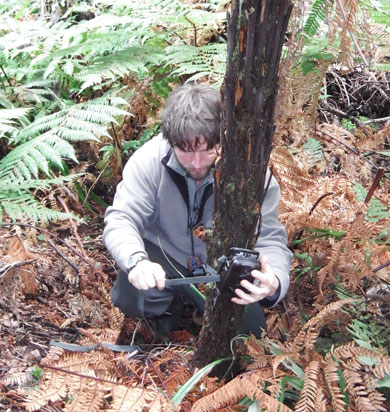Archived content: This media release was accurate on the date of publication.
Date: 05 November 2015

DOC ranger George Nicholas installing a camera to film the rat
The rat arrived on Ulva Island/Te Wharawhara, off the coast of Stewart Island, early in September. It has been filmed eating poison bait pellets and DOC assumes it has died.
An average of one rat per year reaches Ulva Island, most of which swim the 700m from Stewart Island. Nearly all rats are caught in the island’s coastal trap network. However, this particular rat has not entered any traps despite DOC using a range of bait usually attractive to rats. It even ate bait laid at the entrance to one trap but didn’t enter it.
“The rat has not been seen for more than a week so is likely to be dead, however, this isn’t guaranteed without finding the body,” rat eradication specialist Pete McClelland said.
DOC staff put out poison bait pellets where the rat was living after its location was confirmed by trail cameras which video any movement. Bait was put out at dusk and bought in at dawn each day to reduce the risk to non-target species. The rat was recorded eating at least one bait and took away others, as Norway rats often cache food to eat later.
Sandy King and her rodent detecting dog Gadget, who live on Stewart Island, couldn’t find the body when they recently searched the island. This may be because it died in an underground burrow or was eaten by a weka.
“It’s encouraging that Gadget didn’t find any sign of a live rat but, without the body, we can’t be sure we got the target rat. Also, we can’t be sure there was only one rat so we’ll continue to check the traps and tracking tunnels for another month,” Pete said.
“Sandy, Gadget and another rat detection dog and handler will check the island in December and we hope that then it can once again be declared free of introduced predators.”

Rat on Ulva Island

Rat on Ulva Island
Background information
Ulva Island
- Ulva Island/Te Wharawhara (266 ha), located in Paterson Inlet, is a key eco-tourism destination for visitors to Stewart Island. It is visited by 20,000 – 30,000 people per year.
- It is one of the few predator free open island sanctuaries in New Zealand, meaning no permit is required to visit the island.
- Rats were initially removed from Ulva Island in 1995 and it is now home to many endangered birds, including South Island saddleback/tīeke, rifleman/tītipounamu, yellowhead/mōhua, Stewart Island robin/toutouwai and the Stewart Island brown kiwi/tokoeka.
- Most of the island is part of Rakiura National Park and the remaining 7.6 ha, between Post Office Bay and Sydney Cove, while privately owned, is mostly accessible to the public.
Ulva Island Charitable Trust
- The Ulva Island Charitable Trust was set up in 1999 by a group of Stewart Islanders to raise money to upgrade walking tracks and facilities on Ulva Island. Now it continues to raise funds, and in conjunction with DOC, works to keep Ulva Island free of introduced pests and predators.
Rat control on Ulva Island
- A major eradication of Norway rats took place on Ulva Island in 1995.
- In 2010/11, a rat incursion resulted in an established breeding population on the island. An eradication operation took place over the winter of 2011 and the island was rat-free again in 2012. In 2013, three rats were found in traps and a rat control operation over several months was successful.
- While most rats are believed to swim to the island, they’ve been videoed hitching rides on boats. Anyone visiting Ulva Island or any other pest free islands should be cautious. Rats and mice can find their way onto any boat and it’s up to the owner to check it before leaving.
Contact
Jennifer Ross, DOC partnerships ranger
Phone: +64 3 219 0006
Email: jross@doc.govt.nz